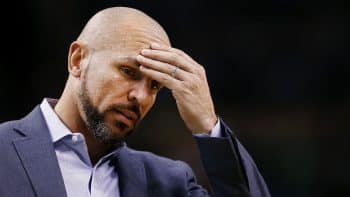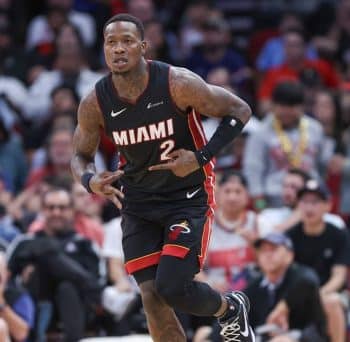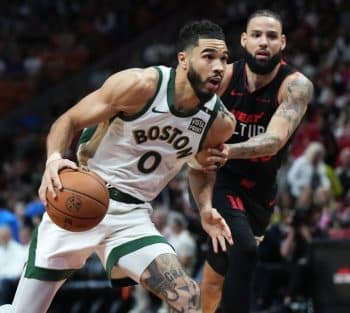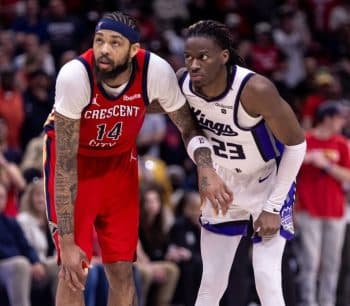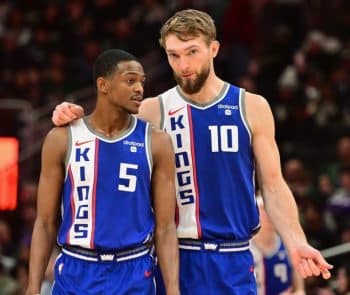NBA
NBA Sunday: Millsap Flying Under Radar

Back in September, after LeBron James had begun his quest in Cleveland and Derrick Rose reintroduced himself to the Chicago Bulls, the Eastern Conference was sure to be a two-horse race between their teams.
Some, perhaps, believed that the upstart Washington Wizards would have an opportunity to make some noise in the conference while others believed that the Toronto Raptors and their continuity would see the Canadian franchise continue to ascend the ranks out East.
But it is the Atlanta Hawks who have soared.
And as the mid-February All-Star break approaches, it is perhaps one of the NBA’s most underrated players who has flown with the Hawks, even if under the radar.
Officially listed at 6’8, anyone who has been in the same room with Paul Millsap knows the listing is liberal, to say the least. Yielding size to opposing forwards on a nightly basis, Millsap is never outworked and rarely unprepared. A consummate professional, over the duration of his nine-year career, he has earned the reputation of being nothing more than a hard worker and astute student.
Before a typical game, while other NBA players listen to music, read books or eat, Millsap is squeezing the last bit of juice out of the scouting report or chatting with a member of the coaching staff. If it’s not head coach Mike Budenholzer himself, then perhaps it is either Darvin Ham or Kenny Atkinson.
In today’s NBA, one of the more discussed themes is the idea of the “underrated” player, but rarely do we ever seek to define the term.
An underrated player is one whose contributions and virtues go largely overlooked in the grand scheme of things, not just by fans, but also by the media.
An underrated player is one who does not attract attention or awe when performing amazing feats on the basketball court – instead, he is often dull and lacks flash or showmanship.
Quite importantly, an underrated player is one who is not paid his fair market value. After all, how can you make the case to be underrated (or under-appreciated) when you are one of your team’s or the league’s highest paid players?
So, if you ever need a player to epitomize what it truly means to be underrated, look no further than Paul Millsap.
——
As a young man, serving as a quarterback in the NFL is what Millsap often dreamed of before he went to bed at night and thought of when he first woke up in the mornings. It wasn’t until the age of 14 that he began seriously pursuing a career in basketball, but he certainly hit the ground running.
By his junior year in high school, Millsap’s 26.4 points and 14.4 rebounds per game helped him achieve local stardom in his home state of Louisiana. He would go on to be named Louisiana Mr. Basketball in 2003 before beginning a standout career at Louisiana Tech. The awards piled up and Millsap made a name for himself, mainly by way of diligent preparation off the court and hard work on it. After three seasons, in 2006, he declared for the NBA Draft.
Questions about his polish, his size or whether he could effectively adapt to life as a combo-forward in the NBA contributed to Millsap’s sliding on draft day, where he would not be selected until the Utah Jazz used its 47th overall pick on him. The list of forwards selected ahead of Millsap includes Andrea Bargnani, Adam Morrison, Tyrus Thomas, Sheldon Williams, Cedric Simmons, Rodney Carney, Renaldo Balkman, Josh Boone, Joel Freeland and a host of other players who are either no longer in the league or have barely made a mark.
From the 2006 class, there are three active players who have been named to an NBA All-Star team: LaMarcus Aldridge, Rajon Rondo and, yes, Paul Millsap.
But back in 2006, before we knew who he was and before Jazz head coach Jerry Sloan knew what he could contribute, Millsap played behind Mehmet Okur, Carlos Boozer, Andrei Kirilenko and Matt Harpring. Slowly but surely, over the course of his rookie year, he earned the respect of his teammates and Sloan’s coaching staff. As the years progressed, his minutes and opportunities did, as well.
It wasn’t until Boozer’s departure to the Chicago Bulls in July 2010 that Millsap became a full-time starter in the NBA, though.
Since then, with the additions of Enes Kanter and Derrick Favors, the Jazz amassed newfound youth in their front court and ultimately decided it best to build around that duo. Despite averaging 17.9 points, 8.7 rebounds, 2.7 assists and 1.6 steals per-36 minutes and shooting 51 percent from the field from the field over the course of his three years as a starter, the Jazz ultimately opted to renounce his Bird rights in July 2013, putting him in the unenviable position of being an unrestricted free agent whose incumbent team could not exceed the cap in order to pay him his full value.
The Jazz essentially opted to allow Millsap to walk away for free in order to build around Kanter and Favors and in order to facilitate the Golden State Warriors signing Andre Iguodala. The Jazz ultimately absorbed the contracts of Richard Jefferson, Andris Biedrins and Brandon Rush and received first-round draft picks from the Warriors in 2014 and 2017 for their troubles.
The 2014 pick eventually became Rodney Hood, and whether or not the trade ultimately ends up paying larger dividends for the Jazz remains to be seen. But the fact of the matter is that with Millsap as a full-time starter, the Jazz had a win-loss record of 118-112; perhaps he could have been a part of the solution in Salt Lake City.
Perhaps he could have at least fetched some sort of return had the Jazz opted to be proactive in facilitating his departure.
Instead, the franchise ended up renouncing him, and in the end, the Jazz proved to be guilty of doing what scores of others had done prior to that point: underrating Millsap.
——
In July 2013, as an unrestricted free agent, Millsap saw Andrew Bynum sign a two-year, $24 million deal with the Cleveland Cavaliers. Only $6 million was guaranteed and that is all Bynum ended up receiving before being traded to and waived by the Chicago Bulls, but that a team was willing to roll the dice and offer Bynum that kind of money showed a deft under appreciation for Millsap.
In the end, Millsap and the Hawks saw something in one another. Newly hired coach Mike Budenholzer and general manager Danny Ferry—both of whom had ties to the San Antonio Spurs—foresaw instilling a culture of selflessness and hard work in Atlanta. Along with Jeff Teague and Al Horford, the thought was that Millsap could help form a triad dedicated not to statistics or glory hogging, but to winning.
Thus far, the results have spoken volumes.
With Millsap joining Teague and Horford, the Hawks began the 2013-14 season as well as could have been expected for a team with new pieces and a rookie head coach. Before losing Horford for the remainder of the season due to a torn right pectoral muscle sustained in the December 26, 2013 contest against the Cleveland Cavaliers, the Hawks began the season with a win-loss record of 15-13.
After losing Horford, the club struggled with size issues and the losses mounted. They would back into the 2014 playoffs at 38-44 but managed to take the top-seeded Indiana Pacers to seven games before being ousted in the first round.
Now, this season, with Horford’s return, the Hawks are building upon their success while Budenholzer and Ferry are seeing their vision come to fruition.
In the NBA, there are some players who have the ability to get their numbers and earn individual honors and there are others who are brilliant leaders and have the ability to help change the culture of a locker room and franchise. Occasionally, you find a player who does both. Millsap is one such player.
Certainly, in Atlanta, he does not deserve all of the credit for the improbable turnaround, but to deny the part he has played in it would be an injustice.
Wanting to install an offense predicated on floor spacing and ball movement, Coach Budenholzer privately challenged Millsap to extend the range of his jump shooting. Budenholzer believed that in order for his mostly undersized rotation to have a chance at sustained success, they would have to employ their speed and nimbleness.
The edict to Millsap was to improve his three-point shooting. The result was him converting more than twice as many three-pointers last season (76) than he converted in the prior seven years of his career combined (31).
He routinely guards and battles bigger players in the post, routinely out-hustling and outmuscling them. He rarely takes a possession off and has been a major catalyst for the turnaround in Atlanta.
As Millsap closes in on what may be his second consecutive All-Star berth in the Eastern Conference, the Hawks brass must be satisfied. For a two-year contract worth $19 million total, Millsap was certainly a risk that has paid off.
And in completely discounting the Hawks as one of the top teams in the Eastern Conference, clearly, we have collectively underrated what Millsap’s impact would be in Atlanta.
As July 2015 approaches, the upcoming free agency class will include the likes of LaMarcus Aldridge, Rajon Rondo, Marc Gasol, Greg Monroe, Jimmy Butler, Kevin Love, Tyson Chandler and perhaps Jeff Green, Al Jefferson, Luol Deng and even LeBron James.
By nature, we pay more attention to the name than the on-court contributions, so it should come as no surprise that the fact that Millsap will also be an unrestricted free agent goes largely unmentioned. As usual, his name doesn’t attract attention and his contributions go largely unnoticed. Even as his Atlanta Hawks soar high above the Eastern Conference and and fly over the Bulls, Cavaliers, Raptors and Wizards, collectively, we ignore the virtues and gifts of one of the game’s hardest workers.
Like James Harden in Houston, he has assisted with a monumental culture change.
Unlike Harden, though, he receives little to no credit for it.
In the end, though, that’s simply life as Paul Millsap.
Next time someone engages you about underrated contributors in the NBA, be sure to mention that they must necessarily fly under the radar. Don’t forget to include the lack of praise he must receive and certainly mention that his salary must pale in comparison to what he delivers on the court.
And before the discussion concludes, be sure to mention the name “Paul Millsap,” because he epitomizes the concept in every imaginable way.
